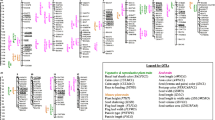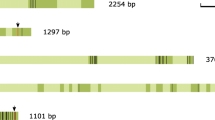Abstract
Biomass yield is an important target trait in Miscanthus breeding for desirable energy crops. Tiller angle is a key trait of plant architecture because it determines planting density and further influences biomass yield through affecting photosynthesis efficiency. TAC1, a major gene involved in tiller and leaf angle control in rice and maize, respectively, has been extensively studied. Nucleotide variation at this gene, MsTAC1, was investigated in 33 Miscanthus sinensis accessions collected from different areas in China, and one genotype of Miscanthus × giganteus. A total of 136 loci, including 129 single base substitutions and seven InDels, occurred within the MsTAC1 gene of 1,874 bp. The genetic diversity at MsTAC1 is characterized by high nucleotide diversity (π value) and high heterozygosity. Clustering analysis indicated that the phylogenetic tree of the 33 M. sinensis accessions was correlated with their geographical sites of origin. The neutrality test revealed no strong selection pressure on coding and non-coding region variations of the MsTAC1 gene in the accessions. Phenotype evaluations were conducted for tiller angle and five other traits in the Miscanthus panels in the first two growth years of 2009 and 2010. Analysis of variance showed significant phenotypic variations in the examined traits. Association analysis using 246 markers detected 88 loci associated with all the test traits in either 1 or 2 years, and 11 of the 88 were year reproducible and thus reliable. These associations indicate that the variation of MsTAC1 affects the phenotypic value of the tiller angle, tiller number and biomass yield, suggesting that allelic variation in MsTAC1 affects multiple traits and demonstrates its significance in Miscanthus breeding programs.





Similar content being viewed by others
Abbreviations
- TAC :
-
Tiller angle gene
- Indel:
-
Insert and deletion
- CDS:
-
Coding sequence
- UTR:
-
Untranslated region
References
Akey JM, Eberle MA, Rieder MJ, Carlson CS, Shriver MD, Nickerson DA, Kruglyaket L (2004) Population history and natural selection shape patterns of genetic variation in 132 genes. PLoS Biol 2:e286
Alonso-Blanco C, Aarts MGM, Bentsink L, Keurentjes JJB, Reymond M, Vreugdenhil D, Koornneef M (2009) What has natural variation taught us about plant development, physiology, and adaptation? Plant Cell 21:1877–1896
Bradbury PJ, Zhang Z, Kroon DE et al (2007) TASSEL: software for association mapping of complex traits in diverse samples. Bioinformatics 23:2633–2635
Chen YN, Fan XR, Song WJ, Yali Zhang Y, Xu GH (2012) Over-expression of OsPIN2 leads to increased tiller numbers, angle and shorter plant height through suppression of OsLAZY1. Plant Biotechnol J 10:139–149
Clifton-Brown JC, Lewandowski I (2000) Overwintering problems of newly established Miscanthus plantations can be overcome by identifying genotypes with improved rhizome cold tolerance. New Phytol 148:287–294
Corre VL, Roux F, Reboud X (2002) DNA Polymorphism at the FRIGIDA gene in Arabidopsis thaliana: extensive nonsynonymous variation is consistent with local selection for flowering time. Mol Biol Evol 19:1261–1271
Dai LJ, Wang B, Zhao H, Peng JH (2013) Transferability of genomic simple sequence repeat and expressed sequence tag-simple sequence repeat markers from sorghum to Miscanthus sinensis, a potential biomass crop. Crop Sci 53:977–986
Doebley JB, Gaut BS, Smith BD (2006) The molecular genetics of crop domestication. Cell 127:1309–1321
Doyle JJ, Doyle JL (1990) Isolation of plant DNA from fresh tissue. Focus 12:13–15
Evanno G, Regnaut S, Goudet J (2005) Detecting the number of clusters of individuals using the software SRUCTURE: a simulation study. Mol Ecol 14:2611–2620
Hall TA (1999) Bioedit: a user-friendly biological sequence alignment editor and analysis program for Windows 95/98/NT. Nucleic Acids Symp Ser 41:95–98
Hardy OJ, Vekemans X (2002) SPAGeDi: a versatile computer program to analyse spatial genetic structure at the individual or population levels. Mol Ecology Notes 2:618–620
Hastings A, Clifton-Brown J, Wattenbach M et al (2009a) The development of MISCANFOR, a new Miscanthus crop growth model: towards more robust yield predictions under different climatic and soil conditions. GCB Bioenerg 1:154–170
Hastings A, Clifton-Brown J, Wattenbach M et al (2009b) Future energy potential of Miscanthus in Europe. GCB Bioenerg 1:180–196
Heaton EA, Dohleman FG, Long SP (2009) Seasonal nitrogen dynamics of Miscanthus giganteus and Panicum virgatum. GCB Bioenerg 1:297–307
Jezowski S (2008) Yield traits of six clones of Miscanthus in the first 3 years following planting in Poland. Ind Crop Prod 27:65–68
Jiang JH, Tan LB, Zhu Z, Fu YC, Liu FX, Cai HW, Sun CQ (2012) Molecular evolution of the TAC1 Ggene from rice (Oryza sativa L.). J Genet Genomics 39:551–560
Jin J, Huang W, Gao JP et al (2008) Genetic control of rice plant architecture under domestication. Nat Genet 40:1365–1369
Jørgensen U, Schwarz KU (2000) Why do basic research? A lesson from commercial exploitation of Miscanthus. New Phytol 148:190–193
Kovach MJ, Sweeney MT, McCouch SR (2007) New insights into the history of rice domestication. Trends Genet 23:578–587
Ku L, Wei X, Zhang S et al (2011) Cloning and characterization of a putative TAC1 ortholog associated with leaf angle in maize (Zea mays L.). PLoS ONE 6:e20621
Li PJ, Wang YH, Qian Q et al (2007) LAZY1 controls rice shoot gravitropism through regulating polar auxin transport. Cell Res 17:402–410
Li Q, Li L, Yang XH et al (2010) Relationship, evolutionary fate and function of two maize co-orthologs of rice GW2 associated with kernel size and weight. BMC Plant Biol 10:143
Librado P, Rozas J (2009) DnaSP v5: a software for comprehensive analysis of DNA polymorphism data. Bioinformatics 25:1451–1452
Nei M (1987) Molecular evolutionary genetics. Columbia University Press, New York
Peng J, Richards DE, Hartley NM et al (1999) Green revolution genes encode mutant gibberellin response modulators. Nature 400:256–261
Peng JH, Ronin YI, Fahima T, Röder MS, Li YC, Nevo E, Korol A (2003) Domestication quantitative trait loci in Triticum dicoccoides, the progenitor of wheat. Proc Natl Acad Sci USA 100:2489–2494
Price L, Bullard M, Lyons H et al (2004) Identifying the yield potential of Miscanthus × giganteus: an assessment of the spatial and temporal variability of M. × giganteus biomass productivity across England and Wales. Biomass Bioenerg 26:3–13
Pritchard JK, Wen X, Falush D (2009) Documentation for structure software: Version 2.3. http://pritch.bsd.uchicago.edu/structure.html
Robson P, Jensen E, Hawkins S, White SR, Kenobi K, Clifton-Brown J, Donnison I, Farrar K (2013) Accelerating the domestication of a bioenergy crop: identifying and modelling morphological targets for sustainable yield increase in Miscanthus. J Exp Bot 64:4143–4155
Swaminathan K, Alabady MS, Varala K et al (2010) Genomic and small RNA sequencing of Miscanthus × giganteus shows the utility of sorghum as a reference genome sequence for Andropogoneae grasses. Genome Biol 11:R12–R29
Tamura K, Nei M, Kumar S (2004) Prospects for inferring very large phylogenies by using the neighbor-joining method. Proc Natl Acad Sci USA 101:11030–11035
Tamura K, Peterson D, Peterson N et al (2011) MEGA5: molecular evolutionary genetics analysis using maximum likelihood, evolutionary distance, and maximum parsimony methods. Mol Biol Evol 28:2731–2739
Tan LB, Li XR, Liu FX et al (2008) Control of a key transition from prostrate to erect growth in rice domestication. Nat Genet 40:1360–1364
Wang ML, Barkley NA, Yu JK, Dean RE, Newman ML, Sorrells ME, Pederson GA (2005) Transfer of simple sequence repeat (SSR) markers from major cereal crops to minor grass species for germplasm characterization and evaluation. Plant Genet Resour 3:45–57
Watterson GA (1975) On the number of segregating sites in genetical models without recombination. Theor Popul Biol 7:256–276
Xu M, Zhu L, Shou HX, Wu P (2005) A PIN1 family gene, OsPIN1, involved in auxin-dependent adventitious root emergence and tillering in rice. Plant Cell Physiol 46:1674–1681
Yan J, Chen WL, Luo F et al (2012) Variability and adaptability of Miscanthus species evaluated for energy crop domestication. GCB Bioenerg 4:49–60
Yang X, Yan J, Shah T et al (2010) Genetic analysis and characterization of a new maize association mapping panel for quantitative trait loci dissection. Theor Appl Genet 121:417–431
Yu J, Pressoir G, Briggs WH et al (2006) A unified mixed-model method for association mapping that accounts for multiple levels of relatedness. Nat Genet 38:203–208
Yu BS, Lin ZW, Li HX et al (2007) TAC1, a major quantitative trait locus controlling tiller angle in rice. Plant J 52:891–898
Yu L, Ding GD, Huai ZX et al (2013) Natural variation of biomass yield and nutrient dynamics in Miscanthus. Field Crops Res 151:1–8
Zhao H, Yu JY, You FM, Luo MC, Peng JH (2011) Transferability of microsatellite markers from Brachypodium distachyon to Miscanthus sinensis, a potential biomass crop. J Integr Plant Biol 53:232–245
Zhao H, Li Q, He JR, Yu JG, Yang JP, Liu CZ, Peng JH (2013a) Genotypic variation of cell wall composition and its conversion efficiency in Miscanthus sinensis, a potential biomass feedstock crop in China. GCB Bioenerg. doi:10.1111/gcbb.12115
Zhao H, Wang B, He JR, Yang JP, Pan L, Sun DF, Peng JH (2013b) Genetic diversity and population structure of Miscanthus sinensis germplasm in China. PLoS ONE 8:e75672
Acknowledgments
This study was supported by the National Natural Science Foundation of China (Grant No. 31100243 and 30870233). The authors kindly thank Prof. Hanhui Kuang at Huazhong Agricultural University for his advice to the work.
Author information
Authors and Affiliations
Corresponding author
Electronic supplementary material
Below is the link to the electronic supplementary material.
Suppl. Fig. S1 Population structure of 34 Miscanthus accessions based on 131 MsTAC1–derived SNP or InDel markers, and 115 SSRs. When K (the number of subgroups) was four, the 34 Miscanthus accessions were classified into four groups
Rights and permissions
About this article
Cite this article
Zhao, H., Huai, Z., Xiao, Y. et al. Natural variation and genetic analysis of the tiller angle gene MsTAC1 in Miscanthus sinensis . Planta 240, 161–175 (2014). https://doi.org/10.1007/s00425-014-2070-x
Received:
Accepted:
Published:
Issue Date:
DOI: https://doi.org/10.1007/s00425-014-2070-x




